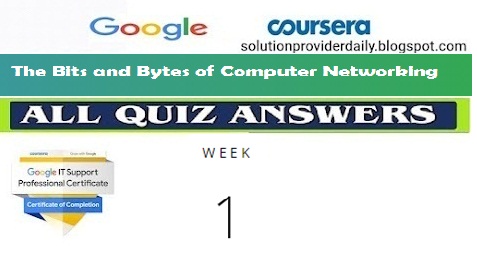Google IT Support Professional:The Bits and Bytes of Computer Networking (Week 1) Introduction to Networking Quiz Answers.
Don't just copy for the sake of completion.
Make sure you understand first.
★Networking Basics★
Q1.When data can flow across a cable in both directions, this is known as _____ communication.
- ethernet
- simplex
- cross talk
- duplex
Duplex communication occurs when data flows in both directions.
Q2.MAC address stands for ____ address.
- media access control
- message authentication check
- maximum allowable cost
- memory access controller
A MAC address is sometimes also referred to as a hardware address.
Q3.Something that requests data from a server is known as a ____.
- switch
- router
- server
- client
A client requests data, and a server responds to that request.
Q4.When an electrical pulse on one wire is accidentally detected on another nearby wire, this is known as _____.
- duplex communication
- preamble
- cross talk
- multicast
Crosstalk is reduced by the way that wires are twisted inside of a cable.
Q5.UDP stands for ______.
- Unified Data Pathway
- Unknown Data Protocol
- Universal Data Protocol
- User Datagram Protocol
User Datagram Protocol is one of the more common transport layer protocols.
Q6.What layer in the Transmission Control Protocol/Internet Protocol (TCP/IP) model does IP use?
- Network
- Transport
- Data link
- Physical
Q7.Which layer in the Transmission Control Protocol/Internet Protocol (TCP/IP) model is responsible for delivering data between two nodes?
- Data link
- Application
- Network
- Transport
The network layer is responsible for sending data between two nodes. The transport layer sorts out which client and server programs are supposed to get the data.
Q8.What type of cable communicates binary data by changing the voltage between two ranges?
- Silver
- Gold
- Copper
- Fiber
Copper cables communicate binary data across wires by changing the voltage between two ranges.
Q9.You have installed a device at the physical layer. All of the systems you connect to this device will talk to each other at the same time. What have you installed?
- Server
- Router
- Hub
- Switch
A hub is a physical layer device that allows for connections from many computers at once.
Q10.You open a web page and log into your email. The traffic travels over many routers. What protocol will the routers use to determine the most optimal path to forward the traffic?
- Transmission Control Protocol (TCP)
- Internet Protocol (IP)
- Border Gateway Protocol (BGP)
- User Datagram Protocol (UDP)
Border Gateway Protocol (BGP) lets routers learn about the most optimal paths to forward traffic.
Q11.How many wires are in a standard Category 6 cable?
- 8
- 10
- 4
- 6
A standard Cat6 cable has 8 wires that consist of four twisted pairs inside of a single jacket.
Q12.What is the most common plug used with twisted pair network cables?
- Registered Jack 35
- Registered Jack 45
- Registered Jack 46
- Registered Jack 11
Registered Jack 45 is the most common plug used in computer networking.
Q13.What is used to determine when the communications channels are clear and when a device is free to transmit data?
- Internet Protocol (IP)
- Carrier Sense Multiple Access with Collision Detection (CSMA/CD)
- Ethernet
- Transmission Control Protocol (TCP)
Carrier Sense Multiple Access with Collision Detection (CSMA/CD) is used to determine when the communications channels are clear and when a device is free to transmit data.
Q14What does the letter B represent in a Media Access Control (MAC) address?
- 10
- 15
- 9
- 11
Since we don't have numerals to represent any individual digit larger than 9, hexadecimal numbers employ the letters A, B, C, D, E and F to represent the numbers 10, 11, 12, 13, 14 and 15.
Q15.What immediately follows the Start Frame Delimiter in an ethernet frame?
- Destination Media Access Control (MAC) address
- Frame Check Sequence
- Payload
- EtherType field
The destination MAC address immediately follows the Start Frame Delimiter.
Q16.Where is the Start Frame Delimiter (SFD) found in an ethernet frame?
- The first byte of the EtherType field
- The last byte of the preamble
- The last byte of the EtherType field
- The first byte of the preamble
一一一一一一一一一一一一一一一一一一一一一一一一一一一一一一一一一一一一一一一一一一一一一一
&
Coursera Google Data Analytics Professional Quiz Answers click here
&
Coursera Google IT Support Professional click here
Have no concerns to ask doubts in the comment section. I will give my best to answer it.
If you find this helpful kindly comment and share the post.
This is the simplest way to encourage me to keep doing such work.
Thanks & Regards,
- Wolf


Comments
Post a Comment